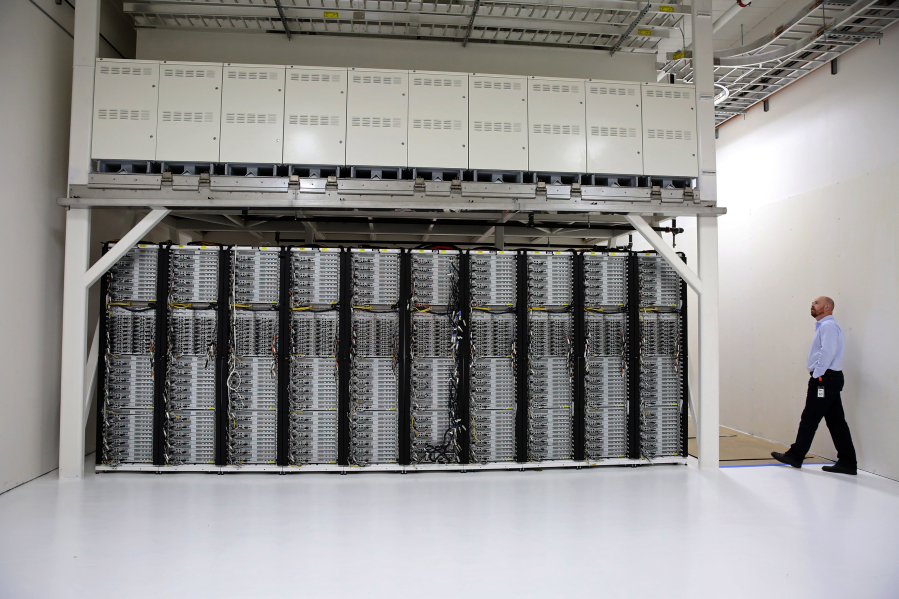SEATTLE — In an industrial space tucked off a side street in Seattle’s Sodo District, Microsoft is trying to reinvent the data center.
Twenty racks of servers sit in a stark, white, well-lit room — a familiar setup for anyone who’s visited one of the data centers that make up the humming infrastructure powering the internet.
To see what’s special about this one, look up: Sitting on a steel frame above each stack of computer hardware is an electrical cabinet the size of a mini-fridge. Inside is a natural-gas-powered fuel cell.
That technology, Microsoft engineer Sean James said, could allow future data centers to someday unplug from the power grid entirely.
By generating electricity close by — literally on top of the computing hardware — Microsoft’s new design eliminates the inefficiency of producing electricity at a distant power plant and transporting it long distances to data centers. That could trim the energy footprint of the fast-growing data-center business, eliminating a portion of the carbon emissions that fuel global warming, and, in the process, save Microsoft a lot of cash.
The company’s Seattle trial is preliminary. But if Microsoft’s estimates hold up — and, a big if, the cost of fuel cells comes down — the savings of a fuel-cell-based design spread across the company’s fleet of facilities could total hundreds of millions of dollars.
James sums up the prevailing view of the plan among the rest of the industry, a group that includes many conservative engineers content to tweak existing designs: “They think I’m crazy.”
• • •
As long as there have been computers, there have been data centers.
The corporate backrooms that housed mainframe computers in the 1970s and 1980s evolved into cavernous spaces full of the servers that underpin the modern internet, storing emails, videos, business tools and the content of websites.
With demand for those services surging along with high-speed internet use, web giants Amazon, Microsoft and Google, as well as specialists like Digital Realty and Equinix, are scrambling to build warehouse-size data centers across the globe.
That business is a massive, and growing, consumer of energy.
Data centers account for about 2 percent of U.S. electricity use, the Department of Energy’s Lawrence Berkeley National Laboratory estimates, up from 0.8 percent in 2000. To cut their costs, companies like Microsoft have designed their newer facilities with energy efficiency in mind.
They’ve also reduced their dependence on fossil fuels by buying renewable energy or building their own wind or solar farms.
But Lucas Beran, who tracks data-center energy economics for IHS Markit, said the industry’s efficiency improvements have started to stall.
“In the next few years we’re going to be at a crossroads,” he said. “We’ll have to change what we’re doing to maintain those energy gains.”
• • •
James and the team of data-center engineers at Microsoft think they’re set to take the next jump forward.
Understanding their thinking requires a tour of a typical data center.
Modern facilities run like small, virtually unpopulated cities, sprawling sometimes across more than 100 acres.
A few dozen technicians manage things from a control room, supplemented by contractors when something goes wrong. Inside central rooms are neat rows of metal cages that hold racks of humming servers. Those stacks churn out a lot of heat, requiring industrial-scale air circulation and cooling systems to keep things from overheating.
Powering all of that is a maze of electrical equipment.
Big data centers typically require their own substation-sized link to the power grid. From there, transformers and switchgear convert incoming electrical current to a lower voltage and regulate its flow with backups, surge protectors and miles of bundled copper wiring.
Because a sudden loss of power could cripple the facility and erase data, backup batteries are also plugged into the grid. As a last line of defense, diesel generators the size of shipping containers sit ready to go from cold and quiet to roaring full power in a few seconds.
Microsoft’s fuel-cell concept would eliminate most of that equipment.
Christian Belady, a data-center engineer who manages Microsoft’s design and research, has hyperbole ready to describe the company’s push to resist traditional thinking.
“I want the data center to disappear,” he said. “And I want energy for free.”



